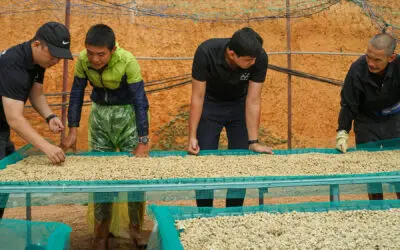As Canadians, we pride ourselves on our coffee expertise and consumption habits—ranking among the world’s top coffee drinkers outside Europe.
Yet beneath our meticulously crafted pour-overs and expertly pulled espressos lies a vulnerability recent trade tensions have painfully exposed: our coffee supply chain’s over-dependence on U.S. intermediaries.
You may have seen Bean Indigo’s recent editorial. It struck a resonant chord with many of you. Behind each bag of Colombian, Ethiopian, or Guatemalan beans in your local Canadian roastery often stands a complex web of importers, brokers, and distributors – many of which are U.S.-based. Similarly, that precision espresso machine in your kitchen may well have traveled through American distribution channels before reaching your countertop. This arrangement has long been convenient, but as international trade relations shift, it now represents a significant liability for our coffee culture and economy.
Exposing Hidden Dependencies
The first step toward supply chain independence is understanding where vulnerabilities exist. Here’s how to identify them:
For Coffee Consumers:
1. Trace Your Coffee’s Journey: Ask your roaster about their bean sourcing path. Does it come directly from origin countries to Canada, or does it make a U.S. detour? Directness isn’t just about freshness—it’s about resilience against trade disruptions. Significant, sudden price hikes may indicate tariffs, but it could also indicate a proactive shift away U.S. supply chains. New volume and business relationships may take time to stabilize.
2. Investigate Equipment Origins: When purchasing brewing equipment, research whether the Canadian retailer sources directly from manufacturers or through U.S. distributors. Many Canadian shops unknowingly rely on American middlemen for inventory.
3. Look Beyond Marketing: Terms like “direct trade” can be misleading if the beans still pass through U.S. importing companies. Request specific information about the importing entity from your roaster.
For Industry Professionals:
1. Audit Your Supply Chain: Document every step your green coffee takes from farm to roastery. Identify points where U.S. or reciprocal tariffs could impact pricing or availability. Many Canadian roasters are surprised to discover they’re paying hidden premiums to U.S. intermediaries.
2. Map Equipment Dependencies: Review your equipment suppliers to identify those sourcing through U.S. channels. Even European machines often enter North America through American distributors first.
3. Examine Contractual Obligations: Revisit contracts with suppliers to understand your exposure to U.S. trade policy changes. Tariffs are levied against the importing parties and flow through to the imposing government and are generally added to or shared by the end consumer. However, many agreements contain clauses that pass tariff costs directly to buyers.
Building Canadian Coffee Independence
Identifying vulnerabilities is just the start. Here’s how we can strengthen Canadian coffee sovereignty:
For Consumers:
1. Support Truly Direct Importers: Prioritize roasters working with Canadian importing companies like the Green Coffee Company, Phil & Sebastian (Calgary), or The Colombian (Edmonton) that maintain direct relationships with producers.
2. Embrace Canadian Equipment Distributors: Look for equipment retailers that have established direct relationships with manufacturers, bypassing U.S. middlemen. Some specialty coffee shops across Canada have begun forming these relationships—ask about their supply chain when making your next purchase.
3. Pay Attention to Origins: Mexican and Central American coffees are particularly vulnerable to U.S. trade disruptions due to geographic proximity and established supply routes. Diversifying your coffee origins creates resilience.
For Industry Professionals:
1. Form Canadian Importing Collectives: Join forces with other roasters to achieve import volumes that make direct relationships financially viable. For assistance with this approach, the Canadian Food Inspection Agency (CFIA) and Agriculture and Agri-Food Canada (AAFC) offer guidance on collective agricultural imports. Additionally, industry organizations like the Coffee Association of Canada can provide networking opportunities for forming such collectives.
2. Establish Direct Banking Relationships: Work with Canadian financial institutions experienced in international trade to facilitate direct payments to coffee producers without U.S. financial intermediaries. Banks like RBC, BMO, and Scotiabank offer specialized trade finance services for importers.
3. Invest in Canadian Infrastructure: Support the development of domestic green coffee storage facilities and distribution networks. Imagine several Toronto-based roasters sharing warehouse space to directly receive and store container shipments from origin, eliminating U.S.-based storage fees and reducing transit time.
4. Diversify Equipment Supply Chains: Develop relationships with European and Asian manufacturers willing to ship directly to Canada rather than through U.S. distribution centres. Several Italian espresso machine manufacturers and Japanese hand grinder companies have expressed interest in establishing direct Canadian distribution channels in response to recent trade uncertainties. You know the brands you promote. Reach out.
The Hidden Cost of Convenience
The convenience of piggy-backing on established U.S. supply chains has come at a price: vulnerability to trade policies beyond our control. While establishing direct import relationships requires investment, the long-term benefits extend beyond avoiding tariffs. Direct relationships typically yield fresher coffee, better quality control, and more meaningful connections with producers.
As our editor aptly noted, this isn’t about politics—it’s about principles. It’s about ensuring that something as fundamental to our daily lives as coffee remains accessible, affordable, and reflective of Canadian values regardless of international politics.
The path to coffee independence won’t be instant—unlike some coffees we refuse to name. But by taking deliberate steps to identify and address supply chain vulnerabilities, Canada’s coffee community can build a more resilient, sovereign coffee culture worthy of our sophisticated palates and independent spirit.
How dependent is your coffee routine on U.S. supply chains? Share your discoveries in the comments below or subscribe to The Coffee Authority Weekly where we will continue to cover trade related issues.



0 Comments